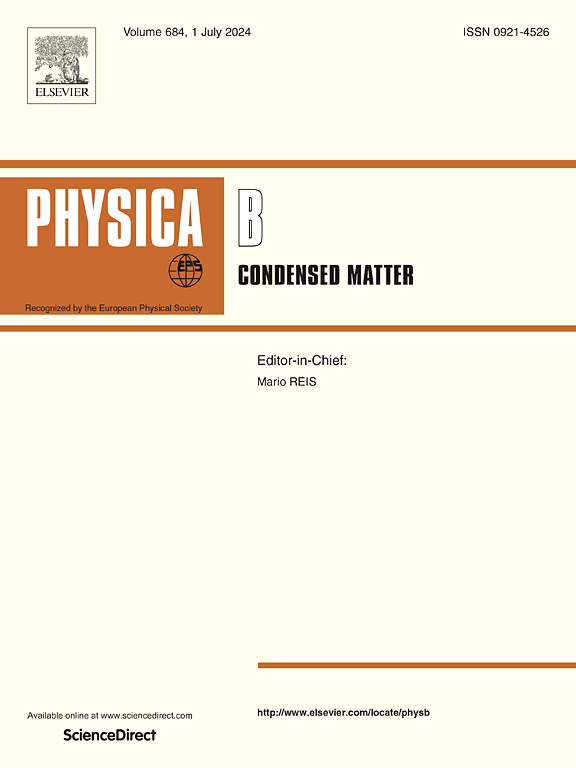Above room temperature TC, 100% spin-polarization, and a high thermoelectric response in the ordered CaCu3Mn2Ir2O12
IF 2.8
3区 物理与天体物理
Q2 PHYSICS, CONDENSED MATTER
引用次数: 0
Abstract
Thermoelectric (TE), electronic, and magnetic properties of the CaCuMnIrO12 structure were studied based on ab-initio approach. Ferromagnetic and two distinct ferrimagnetic (FiM)-I/FiM-II states were examined to figure out the stable magnetic ground state of the system. Our results revealed that antiferromagnetic interactions between Cu/Mn and Ir ions lead to a FiM-II. The charge transport potential for the system is assessed by estimating the various TE factors, where positive S represents the -type semiconducting aspect and a high figure of merit of 0.95 at 300 K, validates the system potential for TE applications. Strikingly, the motif displays a 100% spin-polarization, holding an energy-gap of 0.7 eV in the spin-minority channel, which is high enough to restrict the spin-flipping. Further, the FiM-II ordering is verified from the calculated spin moment of 0.6/3.25/ on the Cu/Mn/Ir ion and form spin-magnetization density isosurfaces. Finally, the estimated Curie temperature () is 322 K.
在室温以上的温度下,ccu3mn2ir2o12具有100%的自旋极化和高的热电响应
采用ab-initio方法研究了CaCu3Mn2Ir2O12结构的热电、电子和磁性能。研究了铁磁性和两种不同的铁磁性(FiM)-I/FiM- ii状态,以确定系统的稳定磁性基态。我们的研究结果表明Cu↑/Mn↑和Ir↓离子之间的反铁磁相互作用导致了FiM-II。通过估算各种TE因素来评估系统的电荷输运势,其中正S代表p型半导体方面,300 K时的高品质值为0.95,验证了TE应用的系统潜力。引人注目的是,基序显示出100%的自旋极化,在自旋少数通道中保持0.7 eV的能隙,足以限制自旋翻转。进一步,从Cu/Mn/Ir离子的0.6/3.25/−0.57μB的自旋力矩验证了FiM-II的有序性,并形成了自旋磁化密度等面。最后,估算出的居里温度(TC)为322 K。
本文章由计算机程序翻译,如有差异,请以英文原文为准。
求助全文
约1分钟内获得全文
求助全文
来源期刊

Physica B-condensed Matter
物理-物理:凝聚态物理
CiteScore
4.90
自引率
7.10%
发文量
703
审稿时长
44 days
期刊介绍:
Physica B: Condensed Matter comprises all condensed matter and material physics that involve theoretical, computational and experimental work.
Papers should contain further developments and a proper discussion on the physics of experimental or theoretical results in one of the following areas:
-Magnetism
-Materials physics
-Nanostructures and nanomaterials
-Optics and optical materials
-Quantum materials
-Semiconductors
-Strongly correlated systems
-Superconductivity
-Surfaces and interfaces
 求助内容:
求助内容: 应助结果提醒方式:
应助结果提醒方式:


